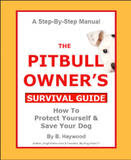Some of the most popular legends. . .
Myth #1: "The CDC says that chained dogs are 2.8 times more likely to bite"
This gross exaggeration has been around for a while, perpetuated by Best Friends Animal Society and other groups that really should know better.
Reality: In 1991 employees of the CDC conducted a telephone survey which was later published by the CDC.
**The results of the survey were never duplicated by any other team of researchers.
**The researchers' own analysis of the data points out limitations to their study.
**The results regarding tethering were one of the study's minor findings.
Myth #2: "Certain dog breeds are more likely to bite"
The usual victim of this particular myth is the "pit bull" -- although the term "pit bull" has come to mean a variety of breeds and types of dogs, and not a specific breed at all.
Reality: There are no reliable, comprehensive statistics on dog bites by breed, and any dog can bite. Most people are bitten by their own dogs.
The AVMA tell us that for all breeds there are factors which affect any dog’s inclination to bite, including the individual dog's “…sex, early experience, socialization and training, health (medical and behavioral), reproductive status, quality of ownership and supervision, and victim behavior.”
(JAVMA, Vol 217, No. 6, September 15, 2000, p. 839).
The often-cited statistics published by the CDC on dog bite-related fatalities -- statistics which have not been updated since 1998 -- specifically opposes breed specific remedies when dog bite controversies develop. The CDC later commented:
"There is currently no accurate way to identify the number of dogs of a particular breed, and consequently no measure to determine which breeds are more likely to bite or kill."
Myth #3: "Studies show that sexually intact (unneutered) dogs --especially males--are most likely to bite"
Reality: While a few studies found a correlation between bites and reproductive status, the correlations are not always positive. For example, some studies show a reduced rate of biting in intact populations. The study so often quoted to "prove" that intact male dogs bite most often (the Denver telephone survey cited above) also found that spayed (neutered) female dogs tended to bite more often.
A very recent study of dog bite injuries in children found that 93% of the dogs involved were neutered.
Bottom line: the causes of dog bites are complex. We need to avoid "quick fix" thinking if we're going to help our communities reduce dog bites.
tags: dog bite prevention, pit bull, spay neuter, tethering, chained dog

